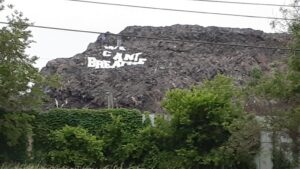Dallas City Council
Stay Inside. Plant Trees. An Annotated Guide to City of Dallas Air Quality Monitoring
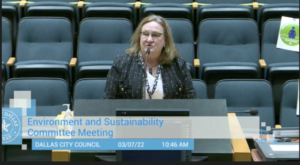
Over the last couple of weeks, the staff responsible for the Air Quality Department at Dallas City Hall’s Office of Environmental Quality have been making the rounds giving presentations about their official air quality monitoring efforts. You can find their complete PowerPoints here as PDFs on the agenda: https://cityofdallas.legistar.com/MeetingDetail.aspx?ID=903849&GUID=B69AEEB6-D5DA-4AE2-B8A4-5BB13C3FD4BE&Options=info|&Search=
The presentations are divided into two parts. The first deals with the monitors placed in Dallas as part of the State and federal enforcement to monitor DFW’s status as a “non-attainment area” for ozone, or smog. The second is about the “non-regulatory” (i.e not EPA-certified) air monitoring staff has been doing that has up to now has been going on under the “Breathe Easy” banner with a fleet of 12 monitors due to expire this year.
New federal grants have made it possible for the City to buy 35 new “non-regulatory” air monitors of various sizes and capabilities that are aimed at “community monitoring.” By the terms of the grants, five of these have to be placed in two West Dallas zip codes. The other 30 include six larger, more sophisticated air monitors that also come with their own metrological towers and will be placed at the City’s discretion.
This is quite an upgrade for a Department that only a short time ago was dismissing the idea of community monitoring and is in their fourth year of rejecting Joppa residents’ pleas for an air monitor in their neighborhood. That’s the good news.
What’s unclear is how all this new monitoring capability will be used to move the needle of air pollution exposure in Dallas.
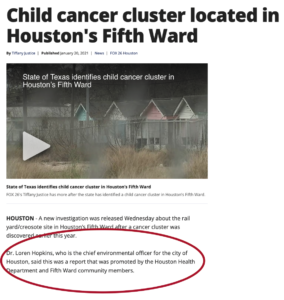
Houston has a staff toxicologist that identifies AND advocates for environmental health. Why doesn’t Dallas?
Is the City collecting air quality data so residents can brace themselves on “bad air days”, or are they collecting it to shape City Hall policy that could reduce air pollution and its impacts?
When the goals of all this City air monitoring come up in the new presentations, there’s no mention mention of impacting Dallas City Hall policy. Instead, there are boasts about gathering ““high quality data,” “contributing to local and regional databases,” and “better understanding the performance of low cost sensors” for “public health measures” and “understanding the role air pollution may play in pediatric asthma” (Really? there’s lots of studies already proving this link)
No suggestion for any pro-active City policy to reduce air pollution. No talking point about using the data to address environmental racism or increase City Hall’s much-valued “Equity” in air quality. There’s a lot of emphasis on collecting data but not much attention paid at all to what will be done with that data.
During the Question and Answer session that followed the presentations in front of the Dallas City Council’s Environmental Committee, staff suggested the results of the monitoring could be used to further the City’s air quality goals like…..staying indoors when pollution is bad, and planting trees to mitigate it. Honest.
Dallas City Council Member Jaynie Schultz:
“What are we going to do to reduce air pollution as a result of this data, this incredible trove of information we’re gathering? ….Will you be proposing to Council different things we can do to reduce that asthma so we can actually affect those numbers?
Office of Environmental Quality and Sustainability Assistant Director Susan Alvarez:
“We are currently working with our Office of Data Analytics to get that data added to the big data website so it will be publicly available. This is one piece of our grant for the West Dallas project; is to also develop appropriate messaging and to work with a non-profit on that to get that message into some of those schools where we have higher than average pediatric asthma rates….
CM Schutlz: But what’s the message? I’m sorry to interrupt.
Alvarez: The message is related to how to, um, best avoid, um, outside, outdoor activities. The other thing that we’re doing is working with the Texas Trees Foundation on, ah, piloting some interventions using nature based solutions, AKA, trees, and they’re working on that right now. They’re already working on planting vegetative screens”
It’s these kind of circa-1990’s answers that reveal why modern public health expertise is so needed at OEQS and City Hall. And not just included in the mix, buy actually driving City Hall environmental thinking. Data collection without application to policy is the Status Quo.
No OEQS staff holds a public health degree, has done research on the public health effects of air pollution, or is charged with evaluating air pollution levels from a public health perspective. When very high levels of air pollution are picked up by any of these new monitors, OEQS won’t have anyone on staff who’ll have the expertise to tell residents what that means.
Instead, the City will still be making residents do all the heavy lifting of solving problems the City helped create. You’re not only assigning them the task of linking pollution levels to impacts but also making it their responsibility to come up with the answer to cutting that linkage. This is what happened at Shingle Mountain. This is what’s happening in Joppa. This is what’s happening in West Dallas. Despite a fleet of new monitors, the City’s stance seems to be that we’re just collecting the numbers. What people do with them isn’t up to us.
Imagine that being the City’s response to finding levels of toxins in tap water faucets in Dallas neighborhoods. City Hall wouldn’t just publish the information in hopes of residents avoiding drinking the water. City Hall would take action to provide fresh water and eliminate the harm. But for some reason the City feels under no obligation to address toxic air quality in homes the same way.
There are a total of 20 slides in the two presentations. Here’s a brief annotated guide to the four slides that provide the crux of the City’s information:
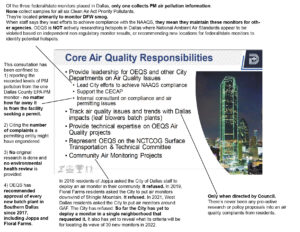
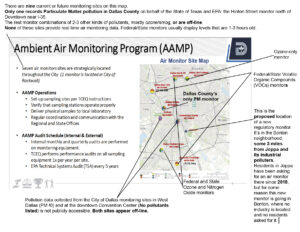
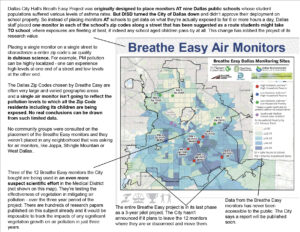
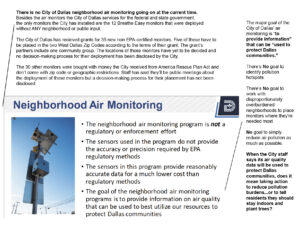
The City of Dallas’ approach to air pollution in its city limits is reminiscent of the old Community Organizing story about the village that finds abandoned babies floating downstream along its river banks and decides to organize to do something about it. At first there’s only a few, but after a couple of weeks there’s hundreds. Adoption bureaucracies are established. Seal Teams of Baby rescuers are on call 24/7. Special baby dams are built.
Until one day some smartass villager asks: “Why don’t we go upstream to see why the babies are ending up in the river?”
Dallas is always responding after the fact to air pollution problems in a downstream way when residents want them to go upstream and solve the real problems. Problems its often responsible for creating in the first place.
Instrumentation without context and action is pointless. “Neighborhood monitoring” without neighborhood oversight is worthless.
If the City of Dallas wants to maximize the potential of so many new air monitors, it needs real public health expertise to tell residents not just to avoid the danger, but how the danger can be eliminated. And neighborhoods must be driving its monitoring deployment process, not just informed after the fact or consulted on a token basis.
But right now there’s absolutely no process in place at Dallas City Hall to ensure either.
Meet the new Downwinders at Risk

Dallas Morning News Consumer Watchdog columnist Dave Lieber found himself listening in on the annual “State of the Air” presentation we’re always invited to give at the Arlington Conservation Council. Lots of information about smog and PM pollution but what really got his attention was the description in the Q&A about the wholesale transformation of Downwinders’ mission and board since 2017. He was so impressed he decided to write about it for his next column. Here’s the flattering result with some great pics our Chair Evelyn Mayo, our founder Sue Pope and (almost) our complete board as of August 2021. Thanks to Dave for the coverage and to all of you for supporting us through this transition.
For those without a DMN subscription we’re reprinting the entire article below:
Top anti-pollution group gets a makeover to an all-women board with young adults and people of color
Most nonprofit boards can only dream of bringing in younger members and people of color to reflect their communities. This one did it.
The phrase “trophy wall” caught my attention.
Jim Schermbeck, the wise old battler against Dallas-Fort Worth air pollution for the last quarter century, was bragging about his group’s new generation of leadership and its new focus on protecting neighborhoods.
I was in a webinar listening to Schermbeck, program director for pollution fighter Downwinders at Risk, as he gave an overview of our air quality (it’s bad!) when the trophy wall thing perked me up. It had something to do with Dallas City Hall officials leaving their jobs. Forgive the gruesome image, but the symbolism was that their heads were hung up on a wall.
I turned up the volume on my computer so I could hear.
He told a story about how the city of Dallas in recent years had allowed two northern Dallas neighborhoods to create their own land use plans. But when two southern Dallas neighborhoods tried to do the same, they were told by the city that neighborhood-based land use plans created by community members were no longer acceptable.
Putting it bluntly, white neighborhoods were allowed to create bottom-up plans that were presented to and accepted by city officials. But these neighborhoods where people of color live were forced to accept top-down plans imposed upon them by City Hall.
Schermbeck mentioned the group’s chair, Evelyn Mayo, a 26-year-old firebrand, and said, “This made her mad.”
Mayo helped organize several groups into the Coalition for Neighborhood Self-Determination, which agitated for fairness in community-created land use plans. Letters were sent to Dallas Mayor Eric Johnson, the City Council and City Manager T.C. Broadnax.
/cloudfront-us-east-1.images.arcpublishing.com/dmn/VHF2H4PGCBFPHDLIWRBDDDUSFU.jpg)
The power play appears to have worked. Three zoning officials decided to retire from the city. They are: Peer Chacko, the city’s director of planning and urban design; David Cossum, development services administrator; and assistant zoning director Neva Dean.
Kris Sweckard, the director of sustainable development and construction, was reassigned to the city’s aviation department on an interim basis.
“So at age 26, this woman has a department head on her trophy wall for a good cause,” Schermbeck was saying. “It’s just amazing to watch. If you ever think young people are not with it, and you want to build your confidence back up about people, please come to a board meeting or hang out with Evelyn and her friends for a while. They will restore your confidence about where we’re headed. She’s an amazing person, and our board is really great.”
/cloudfront-us-east-1.images.arcpublishing.com/dmn/A2SOKXOTI5HBBAGB6CVHNDCLJA.jpg)
Shine a spotlight
I asked Mayo how she felt about the trophy wall analogy. “I don’t think it’s something you should aspire to,” she said. “We were simply reacting to circumstances presented before us.”
Later, she toughened it up a bit, saying: “Whether it’s a trophy wall or not, what’s happening at City Hall is a product of their own incompetence.”
Downwinders board member Misti O’Quinn told me that the coalition shined a spotlight on one portion of neighborhood zoning, and when you shine a spotlight you can expose. What does that mean for city officials? “You take away their sense of security,” she said.
/cloudfront-us-east-1.images.arcpublishing.com/dmn/XOB66IBJRFCCPDQFPUCP7KZPLA.jpg)
I attempted to reach the four City Hall officials but was unsuccessful. When I ran this scenario up the flagpole to Broadnax, he provided a written statement to The Watchdog explaining that when several staffers announced their intention to retire this year, it presented an opportunity to realign their departments.
“Over the next several months,” he said, “we intend to simultaneously restructure permitting and planning and realign the departments and leadership that oversee them. Reorganizing these departments will maximize effectiveness and productivity.”
He made no mention of the coalition or its agitation.
Change with the times
This story runs far deeper than citizen agitation. Downwinders represents a model for how environmental and other nonprofits can alter their profile, their mission and their leadership.
As I looked at the group’s history, I saw how Downwinders has changed in recent years.
Formed in 1994 by Midlothian rancher Sue Pope and other rural residents and suburbanites, Downwinders’ mission for the longest time was fighting pollution caused by cement plants.
/cloudfront-us-east-1.images.arcpublishing.com/dmn/YOOOOF4INFGW5JU7KCBDVI6NUQ.JPG)
But by 2017, the year Mayo joined the board, it was becoming clear — thanks in part to the hideous Shingle Mountain dump site in southeast Oak Cliff — that Dallas needed a spotlight to focus on what activists and academics call historically racist zoning. That’s what allows dirty industries into poorer residential neighborhoods where people of color live. Correcting those inequities is called environmental justice.
In the next two years, the old guard board members, many of whom had served since the group’s creation, all dropped off. The board and its mission changed from rural/suburban to urban.
“It was very traumatic,” Schermbeck recalls. “But I’m so glad we did it because we’re more plugged in than ever before.”
Mayo says the worst moment came in 2019 when she was elected to the unpaid job of chair in what she calls “a somewhat contentious vote.”
The board is now all women; two are Asian-American, five are Black, two are Latina and three are white. Three members are in their 20s, and six are in their 30s. One member is 17 years old.
Most community nonprofits, especially in the traditional environmental arena, can only dream of putting together a board with that diversity.
Mayo, who teaches at Paul Quinn College, has a perfect resume for her leadership role. She majored in environmental science in college with a focus on race and ethnicity.
Working as a paralegal at Legal Aid of NorthWest Texas, she co-authored a study called “In Plain Sight,” which examined the governmental failures that allowed a disaster like Shingle Mountain to spiral out of control.
Then while teaching undergraduates at Paul Quinn, she and her students in 2020 completed a study – “Poisoned by Zip Code: An Assessment of Dallas’ Air Pollution Burden by Neighborhood.” You can guess the results of that survey.
The Downwinders’ main goal, in addition to continuing its legacy battle against dirty air, is to bring power and expertise to the city’s poorer neighborhoods that have had no say in dirty industries moving in.
/cloudfront-us-east-1.images.arcpublishing.com/dmn/3VRLM7INOFGSHGAAN667IY3NYI.jpg)
“The legacy of racist zoning perpetuates unless you fundamentally redraw the map through these land use plans,” she says. “People who are affected must be involved in the decision-making process about what their neighborhood will look like. This will probably have better outcomes for their health and wellness.”
Yet, she adds, “People who live there and bear the brunt of the pollution are still not at the decision-making table.”
Mayo says her group needs all the help it can get.
“No matter who you are, we can put you to work if you’re interested and willing,” she says.
Note: A tip of The Watchdog’s hat to Downwinders’ board members: Cressanda Allen; Satavia Hopkins; Misti O’Quinn; Essence Tetteh; Marsha Jackson; Cindy Hua; Amber Wang; Idania Carranza; Soraya Coli; Amanda Poland; Michelle McAdam; and Shannon Vorpahl.
City Hall’s New Exploding Cigar is Why These Former Plan Commissioners Must Win On Saturday

Dallas City Hall Staff has once again lit an exploding cigar. You know the ones you see in cartoons? An unsuspecting fellow strikes a match to what looks like a normal cigar…and then BAM! Powder burns and singed hair.
This new cigar is being smoked by Staff as if nothing was wrong, but the fuse is already lit. It’s just a matter of time.
Unlike previous Staff-manufactured exploding cigars this one isn’t a project, it’s a process. That makes it an even more insidious threat to Dallas neighborhoods than past exploding cigars sold under the brand names of “Trinity Tollroad,” “Treeless Golf Courses,” and “Gas Drilling in Parks.”
Those were one-offs that affected specific neighborhoods or sections of Dallas. This loaded stogy challenges EVERY neighborhood in EVERY part of town.
This cigar still lacks a catchy battle cry moniker – “Neighborhood Planning Process” is a mouthful and not very descriptive. But the issue is basically self-determination and local control. City Planning Department Staff, led by Director Peer Chacko, are saying Dallas residents can’t be trusted to plot the future of where they live. Chacko and Company have therefore selflessly suggested Staff should take on this task, even if they’ve never set foot in most of the neighborhoods whose fates they’re deciding.
To give themselves veto power over residents, Staff threw away a process where residents had the final say and substituted a new one that doesn’t give residents’ plans any path for Council adoption. Only the Staff-led ones have a chance. “We had to destroy the planning process in order to save it” echos an approach you might remember from more exotic and tragic national exploding cigars of the past 50 years.
Another Bad Sign: Staff invented the need for this new anti-resident planning 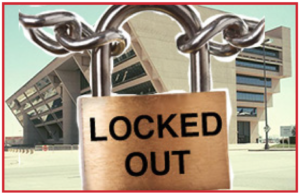 process out of thin air. It wasn’t mandated by a vote from the the City Council. There was no public pressure. No “blue ribbon” panel suggested it. There was no reason to change anything…until there was. Just light that Big Boy up!
process out of thin air. It wasn’t mandated by a vote from the the City Council. There was no public pressure. No “blue ribbon” panel suggested it. There was no reason to change anything…until there was. Just light that Big Boy up!
Is the timing suspiciously racist? Yes it is. After letting a couple of predominantly white North Dallas neighborhoods construct and pass their own plans under the previous system with nary a hint of dissatisfaction, Staff pulled the plug only when Southern Dallas neighborhoods began using it to roll back racist industrial zoning. They might as well have just said, “We certainly didn’t mean for THIS to happen.”
Moreover, Staff believes they don’t need the Council’s permission to trash the neighborhood planning process and replace it with something else they just made up on their own. They’re not asking. They’re telling.
In other words, this is one really big, in-your face, Freudian-inducing, gun powder-packed presumptuous cigar.
Which is why Dallas neighborhood advocates across the city should be rooting for Jaynie Schultz and Paul Ridley to win their run-offs in D11 and D14. When it comes to these kinds of threats, they’re the Bomb Squad of Dallas City Hall exploding cigars.
Both are former Plan Commissioners who have lots of experience running across the room with scissors in the nick of time to cut the burning ends off these things before they can detonate.
As a Commissioner from her own D11 and then stepping in as an interim replacement for D8 a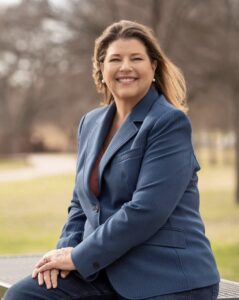 well, Schultz is a major reason there are not now at least four more batch plants in Joppa and nearby Flora Farms. She understands why Flora Farms residents want to rescue their neighborhood from decades of racist zoning. She’s taken on Staff directly and wrangled eight or more votes to deny permits to Southern Dallas polluters that they had no problem allowing. She knows the language of urban planning as well as the process. Her BS antennae are very long and she knows how to win.
well, Schultz is a major reason there are not now at least four more batch plants in Joppa and nearby Flora Farms. She understands why Flora Farms residents want to rescue their neighborhood from decades of racist zoning. She’s taken on Staff directly and wrangled eight or more votes to deny permits to Southern Dallas polluters that they had no problem allowing. She knows the language of urban planning as well as the process. Her BS antennae are very long and she knows how to win.
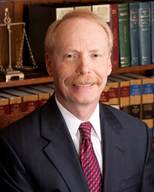 If you like seeing Dallas parks and the Trinity River without any drilling rigs on or near them, you can thank Paul Ridley. That such rigs would be showing up was already a “done deal” according to then-Mayor Mike Rawlings. As a Plan Commissioner during the Dallas Gas Wars Ridley played a critical role in forcing the truth out of Staff and industry so that what looked like a Plan Commission endorsement became a total rebuke that Council then followed. He also speaks Planning, has long BS antennae, and knows how to assemble a winning coalition.
If you like seeing Dallas parks and the Trinity River without any drilling rigs on or near them, you can thank Paul Ridley. That such rigs would be showing up was already a “done deal” according to then-Mayor Mike Rawlings. As a Plan Commissioner during the Dallas Gas Wars Ridley played a critical role in forcing the truth out of Staff and industry so that what looked like a Plan Commission endorsement became a total rebuke that Council then followed. He also speaks Planning, has long BS antennae, and knows how to assemble a winning coalition.
Dallas residents need them both in office in order to lead a freshly-inaugurated City Council to a vote to undo this done deal, before it undoes them.
Already incumbent CM Chad West is reaping the initial whirlwinds of dissent. “The West Oak Cliff Area Planning Initiative” was to be the first uncontroversial example of Staffs’ new system. It’s not going well.
Residents are complaining of a top-down, Staff-led process that excludes many neighborhoods 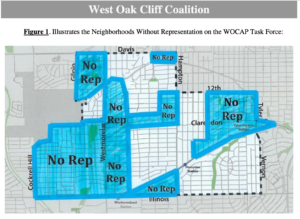 in the large “area” boundary Staff has drawn. They say they aren’t being represented, and the City’s outreach effort is poor to non-existent when it comes to information in Spanish. They also object to the prohibition on adopting their own neighborhood-led plan. A new neighborhood association just formed. The West Oak Cliff Coalition’s first goal is to stop the Planning Department from using its new neighborhood planning process on their neighborhoods. The Coalition’s leadership sent a letter asking West to back their demands. As of this writing, no word from West.
in the large “area” boundary Staff has drawn. They say they aren’t being represented, and the City’s outreach effort is poor to non-existent when it comes to information in Spanish. They also object to the prohibition on adopting their own neighborhood-led plan. A new neighborhood association just formed. The West Oak Cliff Coalition’s first goal is to stop the Planning Department from using its new neighborhood planning process on their neighborhoods. The Coalition’s leadership sent a letter asking West to back their demands. As of this writing, no word from West.
If this is the reaction from previously unorganized neighborhoods in Oak Cliff, imagine the outcry when the full scope of the Staff’s changes become common knowledge among hardcore neighborhood advocates in East Dallas, White Rock Lake, or Lake Highlands. The opportunity for effective city wide organizing is not going unnoticed. It’s all headed for a showdown at the Horseshoe. We just need to make sure Schultz and Ridley are sitting there, scissors in hand, as part of the welcoming committee.
So no matter where you live in Dallas, please help Jaynie Schultz and Paul Ridley out this Saturday – with money, with labor, with a call to friends who live in their districts. The neighborhood you save may be your own. The Bat Signal is on. We’re at DEFCON 1. Dallas needs its Bomb Squad back on duty again.
Current Dallas City Council Members Failed History in 2020. They Don’t Deserve Your Support in 2021
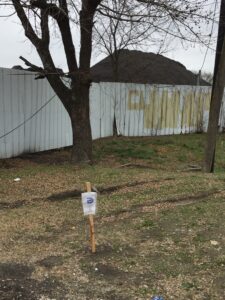
The response didn’t match the crisis. City of Dallas citation notice outside Shingle Mountain in 2019.
For almost two continuous decades Dallas residents had a string of thoughtful, sincere, and righteously-angry advocates who served on their City Council.
As Mayor, Laura Miller just about single-handedly stopped over a dozen new coal plants from being built by Rick Perry and implemented the region’s first Green Procurement ordinance. As a council member, Angela Hunt hunted down waste, corruption, and Staff shenanigans. If she couldn’t get her peers to pay attention, she made sure a reporter did. Scott Griggs and Philip Kingston, then Mark Clayton followed suit. They defeated the zombie Trinity Toll Road AND gas drilling – the latter being “a done deal” according to then-Mayor Rawlings.
Sometimes they fought their council opponents directly. Sometimes they made sure documents that were never supposed to see the light of day got their own spotlight. You knew these partisans would find a way to advance the cause. Because that cause was why they wanted to serve.
But when Griggs couldn’t overcome the cynical Mayoral bid of Eric Johnson, and Kingston’s bad boy behavior cost him his Council seat, the horseshoe lost its last devoted grassroots insurgency. As a result, the current Dallas City Council is the least progressive in deed, if not in rhetoric, since 2002.
Who among the present 15 members could a City Hall observer nominate as the rightful heir of any of those past True Believers? Not a one.
Residents have no confidence that current council members would put ANY cause, no matter how righteous, before their own political ambitions. That’s not a prediction. 2020 provided the proof.
There were exactly two urgent historic crises that brought nationwide attention to Dallas city government last year: Police response to the George Floyd protests, and Shingle Mountain. This Council failed to meet both with integrity.
POLICE ABUSE AND REFORM
Even after the loss of eyes and other serious physical harm inflicted by a Dallas Police Department that was out of control during the May and June protests, not a single Council Member called for the Police Chief to resign. Not a one.
It took the former Chief being caught in a lie regarding that excessive force months after the fact that led to her departure. There were no brave stances from Council Members. Not a one.
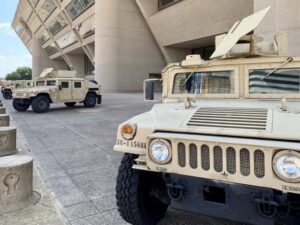
Even after Dallas’ youth and People of Color organized well-attended and persistent protests before and during the budget process to win re-prioritization of police funding, not a single City Council member proposed a budget that reflected their demands. Not a one.
We’ll leave it to the long-time advocates of that cause who are now council candidates, including Changa Higgins, running to replace Adam Bazaldua in District 7, to explain how badly the Council failed to meet the moment. But there’s no question that when a large segment of Dallas residents wanted something done about the use of force and the redeployment of resources away from the Police Department, they had absolutely no champion on the current City Council. Not a one.
What are the consequences to those elected officials for their inaction? For most Dallas “progressive” groups making endorsements on the Council Races, there aren’t any. Not a one.
SHINGLE MOUNTAIN
The entire Council also turned their backs on Marsha Jackson and her neighbors while Choate Street residents suffered daily health problems caused by the City’s most high-profile example of Southern Dallas negligence, Shingle Mountain.
During the 2019 election, 10 current city council members – Chad West, Adam Medrano, Carolyn Kind Arnold, Jaime Resendez, Omar Narvaez, Adam Bazaldua, Tennell Atkins, Paula Blackmon, Cara Mendelsohn, David Blewett – said they’d work to re-establish the Environmental Health Commission if they got elected. Not a single City Council member made a motion to do so when Jackson and her allies asked them to follow through on their commitments last April. Not a one.
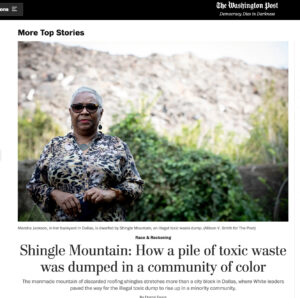
Not a single council member has ever apologized to Jackson. There were no leaking of documents that would have shown just how much the city’s silly demand for some kind of cash payment from the landowners needlessly delayed the clean-up at the dump for over a year. No push back to staff’s irrational claims about why they couldn’t have used the illegal status of the dump to enter the property at any time after it opened and begin a clean-up. Jackson could not count on a single current city council member to be her advocate. Not a one.
While nobody was expecting North Dallas members to take up these causes, there were supposed to be “Progressive” city council members that would carry on the work of Hunt/Griggs/Kingston. Turns out, not so much.
The best that can be said about Chad West is that he’s no Scott Griggs. Adam Medrano seemed to be coasting on his way to terming out. Casey Thomas was never part of that crowd and neither was Carolyn Arnold. Nobody expected much from Jamie Resendez in his first term and he delivered. Paula Blackmon? She was the Mayor Rawlings PR aide when he was calling gas drilling in Dallas a done deal and those Real Progressives were fighting both of them.
But by far the steepest falls from expectations to performance were Omar Narvaez and Adam Bazaldua.
DISTRICT 6

CM Navarez knows the names of every character in the Star Wars universe, but couldn’t name any children suffering under Shingle Mountain.
Almost two years into the job and Council Member Narvaez still tells everyone that will listen that he never expected to be the Chair of the Council’s Environmental Committee and didn’t know that much about environmental issues. His real passion was for housing, but for some reason, the Mayor gave him responsibility for the Environmental Committee, and the shepherding of the City’s precious Climate Plan.
Maybe because of his lack of familiarity with the subject matter, or maybe because it was made clear by the Mayor and Staff that his job would be exclusively about getting the city’s climate plan passed but he froze like a deer in headlights when Marsha Jackson needed him most.
He refused to consider adding the re-establishment of the Dallas Environmental Health Commission to the Climate Plan ordinance despite Ms. Jackson’s personal pleas that she and other residents needed a forum that took these problems seriously.
He kept using the old “it’s in litigation” dodge in public to avoid answering any questions about Shingle Mountain even though city officials routinely discussed it when it suited their PR agenda.
He never met with Ms. Jackson, inquired about her health, toured the mostly Latino neighborhood or asked what he could do as the Chair of the City’s Environmental and Sustainability Committee to relieve their suffering. He never offered to lobby for more air monitoring or health protections. He never offered to do anything.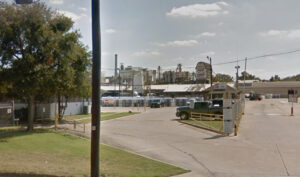
Despite his district hosting the region’s largest asphalt shingle factory (and Sulfur Dioxide polluter), GAF, whose products filled the 6-story Shingle Mountain dump, the Chair of the City’s Environmental and Sustainability Committee never discussed this environmental justice connection between POC neighborhoods in Dallas.
Despite two well-researched published reports identifying vast inequities in the way the City enforces Code in Southern Dallas and how its air pollution burdens are distributed, the Chair of the City’s Environmental and Sustainability Committee held no hearings or meetings related to these environmental justice issues during the last 18 months. Not a one.
Despite national media coverage of the City’s inept handling of Shingle Mountain, and the city’s poor environmental justice record, including articles in the Washington Post and Philadelphia Tribune, and a hour-long documentary on BET, the Chair of the City’s Environmental and Sustainability Committee held no hearings or meetings related to how to avoid another Shingle Mountain during the last 18 months. Not a one.
Despite never holding any meetings devoted to environmental justice the Chair of the City’s Environmental and Sustainability Committee did find an urgent need to convene a special task force to examine and come back with solutions to the pressing issue of Oncor’s cutting down 5 acres of trees near White Rock Lake. Replacing trees in North Dallas, not reducing human suffering in Southern Dallas, was the priority of a council member representing an overwhelmingly POC district, which also happens to the the birthplace of the modern Environmental Justice movement in Dallas.
And of course, the majority of his Committee Chairmanship was spent making sure Staff got its way with the passage of the city’s “North Dallas” Climate Plan, of which many dollars in potential grants depends, if not actual changes on the ground. The plan does zero to address problems like Shingle Mountain and GAF, does nothing for Narvaez’ district, but is very, very concerned about stormwater management and tree cover.
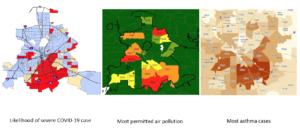
Throughout the entirety of the Shingle Mountain crisis, CM Narvaez was a good soldier for the Mayor and Staff. Which made him an awful Chair of the Environmental Committee for Southern Dallas residents during the most serious environmental justice controversy in the last 25 years.
Not content to just do no good in that case, Narvaez has gone out of his way to praise and campaign with District 8 Council Member Tennell Atkins, a primary architect of Shingle Mountain. In doing so, he fuels Atkins’ mind-blowing Big Lie that he was the facilitator of a clean-up instead of a major obstacle. Atkins is among the most unconscionable right-wing members on the Council but Narvaez treats him like a conquering hero, rubbing salt into Marsha Jackson’s wounds with every unsolicited and unearned act of praise.
Was it embarrassment over this performance this last year that kept Narvaez from granting an interview with Soledad O’Brien for her BET documentary? Instead, the Chair of the City’s Environmental and Sustainability Committee let Atkins alone represent the City on the record.
And he’s followed Staff’s lead right over the cliff on other important environmental health issues too. This might be hard for his Progressive admirers to believe, but he actually bragged about Joppa getting an unprecedented TCEQ air monitor when in fact it’s located three miles north in Bonton.
Then he made that lie worse by claiming that this TCEQ monitor’s location – miles away from industrial sources of pollution in Joppa – could more accurately show what the air was like there than if it had been put in Joppa itself.
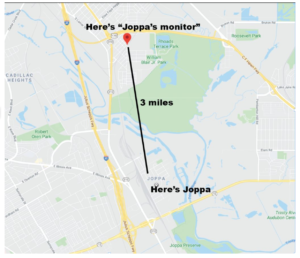 You read that right. According to the Chair of the City’s Environmental and Sustainability Committee, air monitors three miles away from Joppa more accurately reflect the air Joppa residents are breathing than monitors right outside their front doors.
You read that right. According to the Chair of the City’s Environmental and Sustainability Committee, air monitors three miles away from Joppa more accurately reflect the air Joppa residents are breathing than monitors right outside their front doors.
Does CM Narvaez really believe this, or is he just parroting Staff’s opposition to local air monitoring? Which interpretation is more damning?
And what’s his inevitable pretzel logical response to finding out that his own District’s residents are embracing local neighborhood monitoring? Will he be advocating those “local” West Dallas monitors to be located three miles north, in Irving, to get a “truer picture” of West Dallas pollution burdens?
The cynicism is strong in this one.
CM Narvaez should have been the Chair of Housing, not the Environmental Committee. As the latter, he’s set the cause of environmental justice back years. Despite being an over-the-top Star Wars geek, when the time came to make his own choice in his own movie, he went over to the Dark Side.
DISTRICT 7

Despite appearances, CM Bazaldua is neither Jewish or an environmentalist.
CM Adam Bazaldua has disappointed in a slightly lower profile, albeit more personal way.
Bazaldua represents District 7, home to the Freedman’s town of Joppa, and per capita, Dallas’ most polluted neighborhood.
In Joppa sits TAMKO, the other large asphalt shingle factory that operates in a Dallas POC neighborhood. Shingle Mountain is literally right down Central Highway from Joppa, and TAMKO. You can routinely smell its asphalt cooking at all times of day. Along with GAF, it was TAMKO’s products you saw most often being dumped at Shingle Mountain.
But Bazaldua, like Navarez, never brought up that toxic connection that binds his constituents to Choate Street residents. Not once.
In fact, you’d be hard pressed to find anything related to environmental justice concerns uttered by Bazaldua once he took office despite Joppa being a battle ground for such concerns for at least the past three years. He’s conspicuously avoided any mention on it in his campaign material. You’d never know his district was bothered by any pollution problems at all.
When Staff, and CM Navarez told the public there was a new monitor in Joppa that was really in Bonton, he didn’t disagree. He went along with the charade. He didn’t demand overdue air monitoring for a community whose residents had been asking for it since at least 2018.
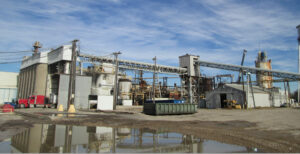 There was no effort by the Council Member to join residents in opposing the Joppa-based Austin Asphalt batch plant permit renewal, even after it was learned that the plant’s air modeling hadn’t been revised from its original sparse West Texas location to reflect its new dense urban Dallas spot.
There was no effort by the Council Member to join residents in opposing the Joppa-based Austin Asphalt batch plant permit renewal, even after it was learned that the plant’s air modeling hadn’t been revised from its original sparse West Texas location to reflect its new dense urban Dallas spot.
There was no call for locomotive electrification in the Joppa switch yard, and in fact two more tracks were laid down that can only result in more carcinogenic black soot from more diesel engines in more locomotives.
Most disheartening however, was the fundamental error in elected official protocol Bazaldua committed last year when Marsha Jackson turned to him in desperation to intervene and advocate for the Dallas Environmental Health Commission on the eve of the Climate Plan vote.
Jackson asked him to look at the language in the proposal she and her Southern Sector Rising allies had 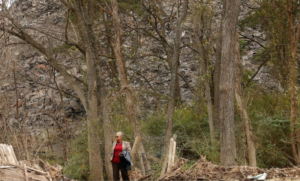 submitted to him. She asked him to take it to Chairman Navarez and make the case for what both had pledged to do less than a year earlier. And then she asked hm to please let her know the results of that discussion before the Council voted on the Climate Plan. He told her he would do so.
submitted to him. She asked him to take it to Chairman Navarez and make the case for what both had pledged to do less than a year earlier. And then she asked hm to please let her know the results of that discussion before the Council voted on the Climate Plan. He told her he would do so.
He didn’t.
When a 61-year old woman being buried daily under tons of waste that the City helped put there comes to you and asks you to plead her case to another Council Member in private and you not only never even read her proposed language, you never bother to even call her back – it is not acceptable behavior from any kind of Council Member, much less one that is described as “progressive.” And no, he never apologized.
What are the consequences to the Council for their collective snub to Marsha Jackson? For most Dallas “progressive” groups making endorsements on the Council Races, there aren’t any. Not a one.
NOT DESERVING
Maybe you think this criticism is all too-narrow. Too specific. It doesn’t account for all the “good things” accomplished by these “progressive” city council members that balance out these woeful absences of empathy and courage. It’s too much to punish them all for losing their way on just these two issues.
But those “good things” were not hard sells, they didn’t require risk-taking. Here’s an exercise: name one issue the Progressives on this risk-averse Council have put themselves, their positions as elected officials on the line for. We’ll wait.
Maybe you weren’t seriously injured by Dallas police in a protest. Your house probably doesn’t back up to 140,000 tons of illegal hazardous waste.
 But maybe next week, next month, or next year you will be in a similar situation. Through no fault of your own you’ll need a Council Member to intervene on your behalf. But if it conflicts with the Staff’s agenda, or makes the Council Member go out on limb, you might be disappointed.
But maybe next week, next month, or next year you will be in a similar situation. Through no fault of your own you’ll need a Council Member to intervene on your behalf. But if it conflicts with the Staff’s agenda, or makes the Council Member go out on limb, you might be disappointed.
If the Council won’t take on the Police when they put out eyes, or polluters when they dump illegally by the truckload, what are the odds your cause will rate action?
That’s the point. Just like all of us, a Council Member shows their true selves in times of crisis, not when the going is easy. In 2020 there were two times history called, and not a single Dallas Council Member answered the phone. Not a one.
What other way can Dallas “Progressives” proclaim these things matter other than using the blunt language of the ballot box and refuse to vote for them? There aren’t any. Not a one.
Support a Dallas Climate Committee AND Restoring the Environmental Health Commission
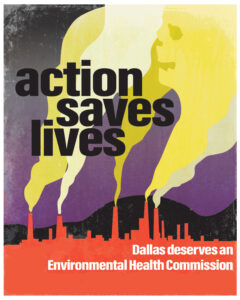
In the next seven days you can help us change the way Dallas City Hall looks at “environmental issues.”
One of the most important lessons of the Shingle Mountain crisis is the high price residents paid by having no environmental health expertise at Dallas City Hall.
This coming Friday, February 12th, the Interim Climate Committee Chaired by former City Council Representative Sandy Greyson is voting on how to organize a new approach to environmental issues in Dallas.
Southern Sector Rising and Downwinders at Risk are formally asking this interim committee to recommend a solution advocated for the last two years by Dallas Environmental Justice advocates: two separate committees. One to track the Dallas Climate Plan, and restoration of the Environmental Health Commission to tackle on-going environmental controversies and policies.
Making sure the numerous climate plan timelines and goals are met will be a full-time job.
EJ advocates say it would be unfair and unwise to also assign this committee the additional responsibility to hear, investigate, and offer policy recommendations on environmental health issues like Shingle Mountain, batch plant permitting, and COVID inequities. They’re urging Former Council Woman Greyson and the Interim Committee to adopt the two committee solution.
You can add your voice to this two committee option by clicking on this link and sending a “ClickNSend” email directly to Chairperson Greyson and Interim Committee members. We’ve got the template written and you can add your own message as well.
If you’re a Dallas resident, please help us bring a much needed focus on environmental health issues to City Hall. Thanks.
We Did This: A Shingle Mountain Clean-Up is Coming
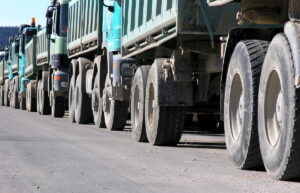
Despite the flurry of cynical and self-serving photo ops and press releases that Dallas City Hall churned out on Monday celebrating the beginning of a clean-up at Shingle Mountain, no waste was removed from the site yesterday. Nor will any be removed today.
But thanks to you, a clean up is coming. And also thanks to all you, that clean-up is suddenly more concerned with the health of Choate Street residents.
Last week, after a required 30-day public notice period, a state court approved a settlement between the illegal dump’s landowner, the State of Texas and the C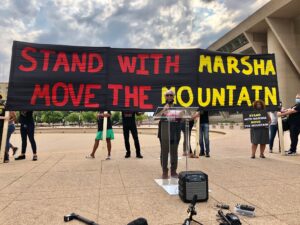 ity of Dallas that sets the table for removal of all “above ground” material. On Monday, contractors for the city were installing air monitors around the dump to record the levels of dust created when bulldozers begin loading the estimated 100,000 tons of hazardous waste into waiting 18-wheelers for the half mile trip to the McCommas landfill.
ity of Dallas that sets the table for removal of all “above ground” material. On Monday, contractors for the city were installing air monitors around the dump to record the levels of dust created when bulldozers begin loading the estimated 100,000 tons of hazardous waste into waiting 18-wheelers for the half mile trip to the McCommas landfill.
According to a separate agreement between the City and the landowner, the City has until December 25th to “begin” the removal process, i.e. sending trucks to actually haul off waste.
This result was anything but a foregone conclusion when the “Move the Mountain” campaign began last August 5th with a new conference at City Hall demanding the illegal dump be gone by the end of the year.
Only 4 months ago City Hall hadn’t made any commitments to a clean-up and had no estimate for when one would take place. The City Council had just unanimously rejected pleas from Choate Street residents to re-establish the Environmental Health Commission as part of a new Climate Plan. We were at a low ebb in our campaign.
But a strategic and constant barrage of public protest and shaming – mock trials, leafleting the Mayor’s law firm, 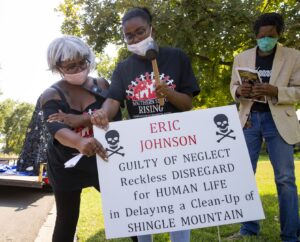 dumping waste at City Hall – along with the attendant embarrassing media coverage, made the City of Dallas actually commit itself to a clean-up it hadn’t planned on doing quite as fast, if at all.
dumping waste at City Hall – along with the attendant embarrassing media coverage, made the City of Dallas actually commit itself to a clean-up it hadn’t planned on doing quite as fast, if at all.
Keeping constant pressure applied for four months was often exhausting, but momentum grew with each new demonstration. November 16th might have seen “peak” Shingle Mountain coverage with publication of a long and well-written expose in the Washington Post, a public demonstration at the dump’s gate counting down the days until a clean-up was supposed to begin and a crew from Solodad OBrien’s upcoming BET documentary in town to film it for a premiere in February.
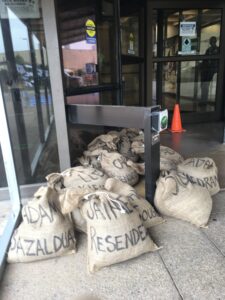 Thanks to everyone who showed up to those demonstrations of support. Whether you attended one or all of them, your presence made a difference.
Thanks to everyone who showed up to those demonstrations of support. Whether you attended one or all of them, your presence made a difference.
Those of you who sent in public comments this last month also had an impact. Initially, neither the State nor City expressed the least bit of concern about the health of Choate Street residents during the messy business of removing the waste. No specific provisions for controlling dust or monitoring air quality were included in the City agreement or State settlement.
But after over 50 letters and emails worth of comments were sent and included in the public record, the City suddenly got religion. It included dust control measures and air monitoring in its final description of the clean-up to the court. Lawyers for Marsha Jackson, Co-Chair of Southern Sector Rising, and a Downwinder board member cited your public comments as the reason the City included these new safeguards at the last minute. So congratulations a second time.
Now what?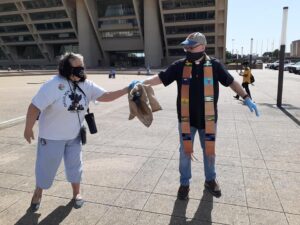
The settlement and agreements signed by the State and City are vague about what happens after the land surface is cleared of waste. Will there be any monitoring wells drilled to see if contamination seeped into the groundwater? Will the clean-up extend below the ground as well as above if the soil is contaminated? If pollution is found in the soil or water, what level of contamination is “acceptable”, i.e. what are the clean-up levels then?
And what and who will be responsible for the health costs -financial and physiological – accumulated by Ms. Jackson and the other Choate Street families?
Residents have drafted their own neighborhood plan for redevelopment that drastically changes the zoning in their community. They’ve submitted it to City Hall. But the same City Council Member that was taking unearned credit for Shingle Mountain’s removal on Monday is fighting this neighborhood plan tooth and nail.
District 8 City Council Member 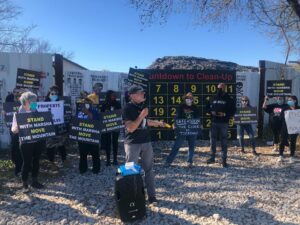 Tennell Atkins is one of the biggest reasons Shingle Mountain exists at all, and why its removal has been so delayed. He’s been nothing but an obstacle to be overcome instead of an ally for his constituents. Adding insult to injury, he’s now standing in the way of Choate Street and Flora Farms residents being able to rebuild their community from the devastation he’s inflicted on them.
Tennell Atkins is one of the biggest reasons Shingle Mountain exists at all, and why its removal has been so delayed. He’s been nothing but an obstacle to be overcome instead of an ally for his constituents. Adding insult to injury, he’s now standing in the way of Choate Street and Flora Farms residents being able to rebuild their community from the devastation he’s inflicted on them.
Atkins is up for re-election in May and it’s our hope that all of you who made this Shingle Mountain clean-up happen will stick around and finish the job by helping us remove this political tumor that threatens the future of Southern Dallas.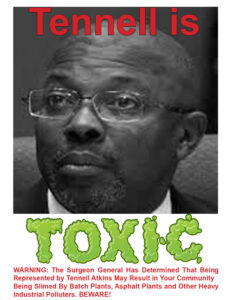
Sunday December 13th was the two-year anniversary of the very first Robert Wilonsky column about Shingle Mountain in the Dallas Morning News. Some of us believed that first column would expose the problem and move officials to act to resolve it. 13 Wilonsky Shingle Mountain columns later, we’re still waiting on the trucks that should have arrived in January 2019.
If they show up before Christmas Day , it will be one of the best, most satisfying moments of a terrible year. But it won’t be the end of the struggle over racist zoning that began on Choate Street. That struggle is just beginning.
Send Your Public Comments for a SAFE Shingle Mountain Clean-Up
What:
Public Comments on the State’s Settlement with Shingle Mountain landowner
When:
Now thru Sunday, Dec 6th
How:
Use our ClickNSend email feature to send your comments to Texas Attorney General’s office in 90 seconds
Why:
To make sure residents’ health is protected during a Shingle Mountain clean-up

A four-month citizens’ campaign pressuring the City of Dallas to clean-up the Shingle Mountain illegal dump in Southern Dallas by the end of 2020 is on the verge of paying off.
Following a pattern that began in summer, on the very same October day groups planning civil disobedience at the dump site announced another action, the City signed an agreement with the Shingle Mountain landowner to take responsibility to “begin” a clean-up by Dec 25th. In return, the City received a check for $1 million from the landowner.
Meanwhile, the state has also reached an agreement with the landowner that clears the way for a clean-up. That agreement is now up for public comment until 12 Midnight Sunday, December 5th.
You can help us protect the health of the Choate Street families most affected by the clean-up by providing your public comments to this State agreement. Doing so sends a message to both Austin and Dallas City Hall that they’re being held accountable now that they’ve been put in charge of removing the 100,000 tons of illegal hazardous waste they helped create.
Public pressure is what’s brought us to this point. Public pressure must now 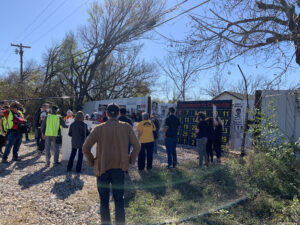 make sure the clean-up itself won’t increase residents’ exposure to hazardous materials like Silica, Formaldehyde, Petroleum By-Products and exotic glues and adhesives used to make shingles that are now crumbling into tons of microscopic particles.
make sure the clean-up itself won’t increase residents’ exposure to hazardous materials like Silica, Formaldehyde, Petroleum By-Products and exotic glues and adhesives used to make shingles that are now crumbling into tons of microscopic particles.
On Monday November 16th, members of Southern Sector Rising, Downwinders at Risk, Southern Dallas Shingle Movers and other protesters gathered at the d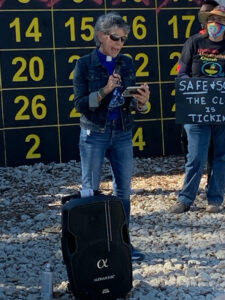 ump’s front gate for an action that hoisted and hooked a huge Clean-Up Countdown Calendar onto the eight-foot-tall metal fence that divides the site from South Central Expressway.
ump’s front gate for an action that hoisted and hooked a huge Clean-Up Countdown Calendar onto the eight-foot-tall metal fence that divides the site from South Central Expressway.
Designed as a giant-size desk calendar, it marked the 30 days of public notice ending on Sunday the 6th. Rev. Frederick Haynes of Friendship-West Baptist Church, Rabbi Nancy Kasten, and the Rev. Amy Moore joined Marsha Jackson and her neighbo rs in speaking about the need to monitor the City and State during this critical phase.
rs in speaking about the need to monitor the City and State during this critical phase.
On the same day, a lengthy expose on Shingle Mountain by Washington Post national climate and environmental reporter Darryl Fears instantly made the dump a national poster child for Environmental Racism.
Two days later, Dallas Mayor Eric Johnson was asked about the Shingle Mountain clean-up by a Channel 8 reporter during his City Hall press conference on rising crime rates in Dallas. His revealing answer beginning with, “It’s really a legal problem,” confirmed the City always had the option of cleaning up the dump, but delayed doing so for over 18 months until it had received money from either the operators or landowners. Admitting that the City could have “solved” this problem early on, Johnson said the City choose not to because that would have made the City’s lawsuit against the landowners “moot.”
Moot is a lawyer’s term that’s defined as “of little or no practical value, meaning, or relevance; purely academic.” Instead of making their lawsuit moot by immediately cleaning up a site causing daily human health damage, Mayor Johnson and the City of Dallas rendered the health of Marsha Jackson and the Choate Street families moot. They made it of little or no practical value in the City’s approach. Of much greater value was the cash received by the landowners. The City sacrificed a street full of its own residents for a lousy $1 million.
In his three-m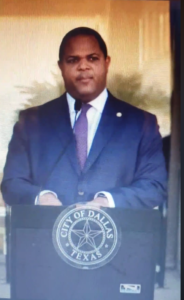 inute response, Johnson never uttered Marsha Jackson’s name, never addressed residents’ health issues, and never expressed regret, second thoughts, or apologies over the year and half the six-story waste pile harmed Choate Street residents. He never admitted the City’s multiple failures in code enforcement, zoning or environmental regulation that paved the way for Shingle Mountain’s creation. He complained how the City was put in a “tough position” – never considering how tough it might be for parents to watch helplessly as their child coughs-up pieces of ground-up shingles. Mayor’s Johnson’s answer was full of legal rationale but completely devoid of humanity or self-awareness. There were no people in it.
inute response, Johnson never uttered Marsha Jackson’s name, never addressed residents’ health issues, and never expressed regret, second thoughts, or apologies over the year and half the six-story waste pile harmed Choate Street residents. He never admitted the City’s multiple failures in code enforcement, zoning or environmental regulation that paved the way for Shingle Mountain’s creation. He complained how the City was put in a “tough position” – never considering how tough it might be for parents to watch helplessly as their child coughs-up pieces of ground-up shingles. Mayor’s Johnson’s answer was full of legal rationale but completely devoid of humanity or self-awareness. There were no people in it.
In short, it was an articulate if soulless synopsis of the City’s position regarding not only Shingle Mountain, but all environmental health problems in Dallas. Because at Dallas City Hall there is no such thing as human-centric environmental problems. What was the City’s first legal response to Shingle Mountain? It wasn’t to cite what an illegal awful abomination it was, but to take it to court over storm water violations. There were no people to worry about. Besides the inability of the City to protect its own residents from illegal hazards is the fact that it continues to treat Choate Street residents as spectators to their own disaster. Marsha Jackson is the Invisible Woman.
In May the Dallas City Council unanimously rejected the pleas of Ms. Jackson and Southern Sector Rising to re-establish the Dallas Environmental Health Commission to give an institutional voice to their concerns within City Hall; to put people back into the mix along with tree planting and water conservation. The Council turned its back on her – again.
That’s why your public comments about maintaining the safety of the pending clean-up are important.
Please show the City of Dallas that you care about Marsha Jackson and the families on Choate Street – even if it doesn’t. Thanks.
CLICK HERE TO SUBMIT YOUR COMMENTS
Memo: Vote on Dallas Climate Plan Scheduled for May 27th…via Zoom?
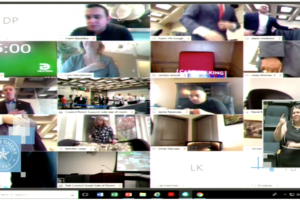 Disregarding calls to postpone a vote on its controversial Climate Plan until the Dallas City Council can resume traditional public participation in meetings, Council Environmental Chair Omar Narvaez has set a May 27th date for full council approval.
Disregarding calls to postpone a vote on its controversial Climate Plan until the Dallas City Council can resume traditional public participation in meetings, Council Environmental Chair Omar Narvaez has set a May 27th date for full council approval.
According to an April 9th memo Narvaez sent to the rest of the Council, the newest draft of the plan will be unveiled online on April 21st with a full briefing to the Environmental And Sustainability Committee scheduled on May 4th if that’s possible. If not, the full council will get a briefing on either May 6th or 20th.
While current local Shelter-in-Place orders expire at the end of April, most experts believe those should be extended through May and there’s no timeline for reinstating in-person public meetings of any local city councils or other governing bodies. If the City follows Narvaez’ schedule, it’s uncertain under what circumstances the Dallas Plan would be adopted, and how much public participation would be allowed.
That Dallas’ plan might be approved while by-passing the usual democratic niceties is just one more way it’s managed to elude real public engagement and transparency over the past two years. From beginning to end, the project has been a consultant and staff-led exercise with just enough of a thin veneer of “public participation” to reassure the unaware.
[pdf-embedder url=”https://www.downwindersatrisk.org/wp-content/uploads/2020/04/CECAP-memo_040910.pdf” title=”CECAP memo_040910″]
In the memo, Narvaez goes to great lengths to recap City Hall’s efforts at including “the public” in the plan. He cites the plan’s Stakeholder process, where staff hand-picked its own City Hall-friendly review committee. Not cited is the strange fact that there’s never been a list of individual stakeholder participants released and anyone wanting to know who was representing “the public” in the process had to submit an Texas Open Records Act request to City Hall to find out. Navarez also recounts the previous briefings his Committee has received from staff – but not the fact that no public participation was allowed in those briefings.
Neither does Narvaez mention that some of the Plan’s own official stakeholders are in open rebellion over its uninspiring results, including allies who were practically embedded with city staff for months. There are at least two separate on-going efforts by former stakeholders to try and strengthen the Plan before passage.
But the same divisions that have plagued Dallas environmental groups since the Plan’s announcement are dividing it at the end of the process as well. Representatives of larger mainstream groups like the Sierra Club and Public Citizen are pushing for quick adoption of the Plan, while Texas Campaign for the Environment, the local fledgling Sunrise Movement chapter, and others are seeking delay until citizens are allowed to come back into the Council Chambers and speak directly to their representatives – without the help of Zoom.
One recent development of the Plan that could be actually be relevant for ordinary residents is talk about restoring the Environmental Health Commission as a way to monitor the Climate Plan’s progress as well as serve as a new forum for residents’ concerns. Eliminated ten years ago just as secret gas drilling deals were being written by then City Manager Mary Suhm, the Commission had previously acted as the Council’s eyes and ears on all things related to public health and successfully advanced policy on a variety of fronts, including practical elimination of all waste incineration in Dallas.
Downwinder allies in The Southern Sector Rising Campaign for Environmental Justice called for restoration of the Environmental Health Commission last year at its March 20th news conference at City Hall and has been lobbying to bring it back ever since. Responding to a 2019 Dallas Green Alliance questionnaire, 10 of 15 current Council Members approved of the idea, so theoretically at least, it might be an easy sell.
If restoration of the Commission as previously fully empowered were to actually be included in a final Climate Plan package, at least something of practical real word use would have been purchased with the $500,000 + spent to date on the effort.
Our past coverage of the plan:
February 2019: “All Plan, No Action: Dallas City Hall’s Approach to Climate Change”
March 2019: “Dallas Climate Plan’s ‘Public Participation’ is Neither Very Public nor Participatory”
May 2019: “Dallas’ Climate Plan Rolls Out Public Engagement Plan. Public is MIA.”
November 2019: “The Only Thing Missing in Dallas’ Climate Plan “Focus on Equity” is…any measure of Equity”
February 2020: “How the Dallas Climate Plan Baits and Switches on Air Pollution”
March 2020: “Biggest Disappointment of the Dallas Climate Plan? Greens Giving Away Their Power For So Little in Return.“
The Only Thing Missing in Dallas’ Climate Plan “Focus on Equity” is…any measure of Equity
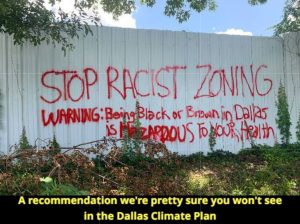
A staff presentation focusing on Dallas environmental equity lacks any metrics for comparing residential pollution burdens, or even for measuring the success of its own outreach effort.
So how does City Hall know what environmental “equity” looks like?
According to management guru Peter Drucker, “If you can’t measure it, you can’t improve it.”
Then what does it mean that a full year into a Dallas climate planning process heavily touted as reflecting the city’s emphasis on “equity” there’s still no map showing how pollution burdens are distributed across Big D? And what does it tell you when a presentation meant to advertise the inclusiveness of the City’s outreach effort for its climate plan doesn’t document participation by residents of color?
It tells you that despite all the rhetoric on the subject, Dallas City Hall isn’t serious about environmental justice yet.
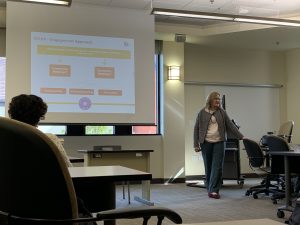
Office of Environmental Quality and Sustainability Susan Alvarez presents the City’s climate plan through “an equity lens.”
Exhibit A: “Dallas’ Climate Action Through an Equity Lens.” 



This was a presentation that Susan Alvarez, Assistant Director of the City of Dallas Office of Environmental Quality & Sustainability, gave as part of Eastfield College’s Sustainability as a Social Justice Practice: Developing Resilient Strategies held last Friday, November 8th.
Context is everything and so it’s important to note that the entire thrust of both the Conference and the City’s specific presentation was aimed squarely at how to respond to current environmental challenges in an equitable and just way. Here was a chance for Dallas OEQS city staff to display their embrace of equity as it relates to the climate plan it’s been paying a half-million dollars to consultants to construct. It was their very own EJ report card.
Equity and the Climate Plan:
And sure enough, there was no turning away from Dallas’ racist history in Alvarez’ presentation. Maps showing the City’s chronic segregation and poverty were included, as well as allusions to the Trinity River as the city’s dividing line between Haves and Have-Nots. Alvarez spoke about the current “Redlining Dallas” exhibit at City Hall that traces the City’s history of racism across 50 feet of photographs and stories.
In fact, just about every impact of the City’s official segregation was referenced, except for the one you’d expect.
There was not a single slide or sentence expended on the disproportional environmental impacts of 100 years or more of Dallas racism. No maps of where heavy industry zoning is allowed in the City. No maps of where most of the City’s largest polluters are located. No maps of what zip codes or Council Districts have the highest pollution per capita numbers. No references to past environmental justice struggles with the City like the West Dallas RSR fight, or gas drilling.
Watching the presentation you’d get the impression that racism infected every aspect of life for Dallas residents of color except for their exposure to pollution. But of course, we know that’s not true.
During this and other presentations on the climate plan-in-progress, staff go out of their way to point out that industry makes up “only 8% of emissions.” But if you’re interested in applying “equity” to this number the next slide should show the audience where that industry is distributed in Dallas – a map showing you where industrial polluters are allowed to set-up shop. A slide to show you the amounts of permitted pollution by Zip Code, or maybe actual 2017-18 emissions by Council District. But there is no next slide.
If there were, it would show that most of that industry is located in predominantly Black and Brown neighborhoods. Racist zoning is at the heart of not just banking, education, and employment inequities in Dallas. It also means the dirtiest industries have always been located in close proximity to people who were institutionally considered Second-Class citizens.
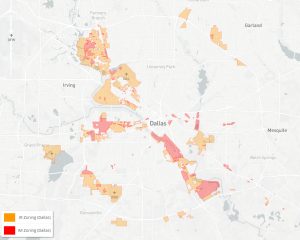
This one slide is already more information on Dallas environmental equity than you’ll find in the entire City staff presentation on equity and the climate plan
Disproportional exposure to industrial pollution by residents of color is not just AN equity issue. It’s THE single most important equity issue when you’re speaking about environmental justice in Dallas. The City’s Black and Brown residents are more likely to be exposed to harmful pollution than their white peers because the City’s own zoning designed it that way – but you’d never know it watching this presentation, on equity, at the social justice conference.
The “Redlining Dallas” exhibit that Alvarez cited thinks so. Along with other insidious effects of racism, it gives space to the RSR clean-up fight Luis Sepulveda and his West Dallas Coalition for Environmental Justice waged in the early 1990’s. But there was no mention of that fight or any other Dallas examples during the presentation on equity, at the social justice conference.
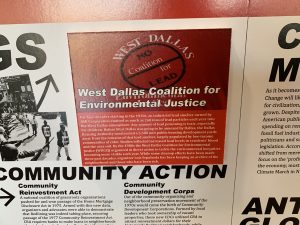
Staff referenced every other kind of red-lining on display at the City Hall exhibit – except the one most relevant to the topic.
Nor was there any mention of how much industry was located in the Trinity River floodplain, doing business in Black and Brown neighborhoods founded because the City wouldn’t allow these so-called “undesirables” to live anywhere else but side by side with “undesirable” industries. Alvarez made the point in the presentation that climate change means more flooding in general and more severe flooding. The next slide should show who and what is affected by that new flooding risk. A slide showing what percentage of heavy industry is located in the flood plain. A slide showing what the racial make-up and income levels are of those who’ll be more affected by increased flooding…and contamination. But there was no next slide, in the presentation on equity, at the social justice conference.
If you don’t have accurate maps of the inequities plaguing the status quo, how do you know when or if you’re ever getting rid of them? How do you judge success without a baseline?
PR, Process and Equity:“I don’t think it’s important to say I’ve got four black people in my stakeholders group.”
Alvarez lowered expectations for the presentation by saying it would only look at the question of equity in how it was applied to the City’s climate plan “community engagement.” No actual equity policy options from other plans were on the table, just how well the plan’s public relations campaign did.
Not very well, she admitted. In fact the initial meetings and publicity were so anemic that she said the professional PR folks at Earth X had a come-to-Jesus-meeting with staff about a reboot. So that’s tens of thousands of dollars wasted on PR consultants only to be usurped by better free advice from locals.
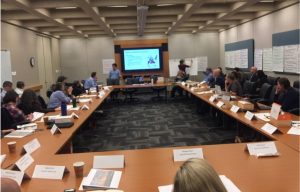
A meeting of the Dallas climate plan advisory group.
In her recounting of the climate plan’s PR rollout and planning process Alvarez gave an overview of the mechanics. “X” number of meetings attracted “X” numbers of people. The City’s survey got “X” number of responses. An “X” number of people serve on an advisory stakeholders group.
Considering the very specific circumstances of the presentation, the next slide should have been how the results of those attending meetings, or completing a surveys, or advisory committee memberships reflect Dallas’ population as a whole. How do we stack up to who we’re representing? According to the Statistical Atlas Dallas is approximately 25% Black, 41% Hispanic , 30% White and 3% Asian. So the next slide should compare what percentage of those attending climate plan meetings, or completing surveys, or becoming advisory committee members were Dallas residents of color vs the city demographics.
But there was no next slide about how inclusive the City’s climate plan community outreach or advisory process has been in the presentation on equity, at the social justice conference.
In response to a question about the lack of such information Alvarez said it was irrelevant to the topic at hand. “I don’t think it’s important to say I’ve got four black people in my stakeholders group.”
Since the advisory group membership is only listed online by organizational affiliation it’s impossible for anyone outside the meetings to know what the ethnic or gender make-up of it is. There are 39 separate entities listed. 25% of that number would be nine to ten black people.
In elaborating, Alvarez challenged the idea that mapping Dallas’ racial or ethnic disparities in pollution 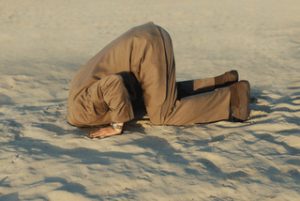 burdens was necessary to understanding “Dallas’ Climate Action Through an Equity Lens.” She more or less stated it didn’t matter. (the presentation was recorded by Eastfield College and Downwinders has asked for access to it in order to quote Alvarez accurately).
burdens was necessary to understanding “Dallas’ Climate Action Through an Equity Lens.” She more or less stated it didn’t matter. (the presentation was recorded by Eastfield College and Downwinders has asked for access to it in order to quote Alvarez accurately).
Nothing could better summarize the kind of Catch-22 “don’t confuse me with the facts” approach to “equity” the City staff has taken in regards to environmental racism than the belief that actual data about Dallas environmental racism is of no use to the study or remedying of Dallas’ environmental racism.
And nothing makes a better case for the need to pass environmental justice reforms the Southern Sector Rising Campaign is advocating at Dallas City Hall, including an environmental justice provision in Dallas’ economic development policy, restoration of the Environmental Health Commission, and creation of a Joppa Environmental Preservation District. If residents want environmental equity considered in city policy they’re going to have to enlist their City Council members, do it themselves, and enact reforms like these.
The same is true as City Hall ramps up to take on citywide land-use planning in its “forwardDallas!” process early next year. When staff recently released the City’s “equity indicators” report, there was an indicator for everything but the environment. It only reinforced the idea that the environment, and environmental justice, are still after-thoughts in Dallas city government. Residents will have to arm themselves with the information the City staff can’t or won’t provide. They should start with the recent Legal Aid report “In Plain Sight” that demonstrates deep neglect for code and zoning regulations in Southern Dallas.
And it also goes for the climate plan. Southern Sector Rising’s first recommendation for the city’s climate plan last May was “Remove industrial hazards from the flood plain.” On the other hand, the idea of land use reforms in the floodplain hasn’t appeared in any official literature or presentation associated with the city’s climate plan.
Grist recently published an article about the Providence Rhode Island climate planning process that looks to be the exact opposite of the model Dallas has adopted. But that city benefited from having an environmental justice infrastructure already in place when the climate crisis assignment arrived. Where’s the home for Environmental Justice in Dallas City Hall? Right now, it’s with staff that doesn’t think metrics about equity are important, in its presentation on equity, at the social justice conference.
VOTE!
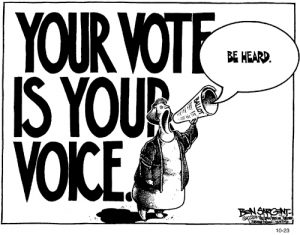
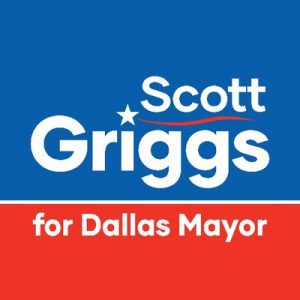
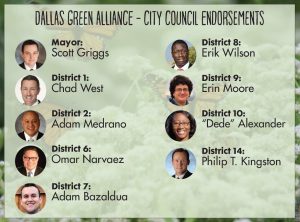
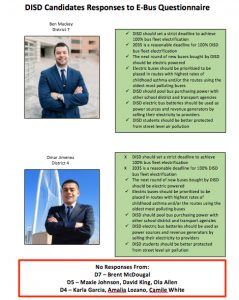
For the first time in its history, Downwinders at Risk is endorsing a candidate for Dallas Mayor. Scott Griggs has been a reliable ally to clean air advocates since he was first elected to the Dallas City Council in 2011. He led the successful fights opposing both the Trinity Toll Road and illegal gas drilling in Dallas parks. He’s the only candidate in the Mayor’s race with a proven track record of working on behalf of the Dallas environment and public health.
We’re listing the Dallas Green Alliance city council endorsements here as a kind of Green voter’s guide for those interested in other Big D races.
Finally, we sent what we think is the first questionnaire to DISD board candidates that focuses on electric buses and public health. Response was underwhelming with only two of nine candidates bothering to answer and we present their answers here. This lack of replies is probably an accurate reflection of the awareness level of the issues within the School District itself. But we’re determined to change that.
In many ways, this May 4th election is as important at themid-terms were last November in changing the balance of power.
Don’t sit it out.

/cloudfront-us-east-1.images.arcpublishing.com/dmn/KAAKWCLEMNCRXNYABMHB33CEPA.jpg)
